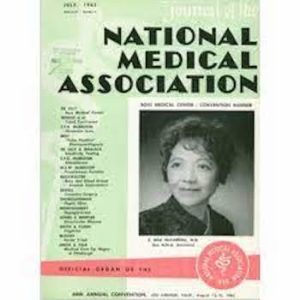
Earnest Mae McCarroll
*Earnest McCarroll was born on this date in 1898. She was a Black physician.
Earnest Mae McCarroll was born to Mary and Ernest McCarroll in Birmingham, Alabama. Her father was a mail carrier. She was the fourth of their six children. She attended public school in the city until receiving her high school education and secondary training at Talladega College, graduating with her Bachelor of Arts in 1917. She then completed her required chemistry and physics courses at Fisk University in Nashville, Tennessee. Soon, she moved to Philadelphia and was awarded her Medical doctorate from Woman's Medical College of Pennsylvania in 1925.
After completing her internship in Kansas City, Missouri, at General Hospital No. 2, she started her career in general practice in Philadelphia in 1927. She moved her practice to Newark, New Jersey, after her marriage to Dr. J. Le Roy Baxter on March 31, 1929, she became the first Black appointed to the Medical Staff at the Newark City Hospital. McCarroll was appointed a clinic physician in the Venereal Disease Division of the Newark Department of Health in 1934 due to her efforts in Sexually Transmitted Infection eradication. Eventually, she became the city's assistant epidemiologist. In 1939, she earned her Master of Science in Public Health at the Columbia University College of Physicians and Surgeons. She did her postgraduate education at the Harvard School of Public Health.
In July 1941, her work "Standard Curative Treatment of Early and Late Syphilis" was published in the Journal of the National Medical Association. McCarroll heralded the effort to end sexually transmitted infections during the early days of Franklin D. Roosevelt's New Deal, when Thomas Parran Jr., notorious for the Tuskegee syphilis experiment, was the Surgeon General of the United States Public Health Service. In 1946, the Newark City Hospital appointed her as part of their medical staff, making her the first Black to do so. A doctor shortage due to World War II increased the opportunities available to women and Black physicians. Post-war, seven years later, in 1953, she was also named the city's Deputy Health Officer.
The Newark Beth Israel Hospital, still functioning under Jim Crow "separate but equal" practices, granted her courtesy privileges to practice. She joined the National Medical Association in 1929. She held multiple positions throughout her career, such as a member of the Board of Trustees for the organization's academic journal (1949-1955 and 1963-1973) and a chairman of the Committee on General Practitioner of the Year Award (from its inception 1955-1968) and the Publication Committee for 32 years.
She performed several other services for the organization and was named "First Lady of the NMA." McCarroll worked on state and local levels as president of the New Jersey Medical Society and the New Jersey State Medical Association. In addition, she was a member of the Essex County Medical Society, the State Medical Association of New Jersey, the American Medical Association, the American Venereal Disease Association, and the American Public Health Association. She also served as the president of the North Jersey Medical Association and the New Jersey Medical Society. At the same time, medical organizations in the South and Washington, D.C. still barred Blacks.
She was also a board member of the Newark branch of the NAACP, the Union League of Essex County, and the Full Neighborhood Guild. She organized the Neighborhood Guild and was a member of the Bethany Baptist Church, the League of Women Voters, the Daughters of Elks, and the Delta Sigma Theta Sorority. She was a member and fieldworker of the Planned Parenthood Association of New Jersey. The North Jersey Medical Society awarded her a plaque 1955 as its first "General Practitioner of the Year."
In July 1963, she became the first female physician whose picture appeared on the cover of the NMA Journal. The journal typically only showed recently retired or deceased at the time, but they added her picture to honor her services. Slightly over a decade later, on August 14, 1973, the organization presented her a plaque reading: "In recognition of her dedicated involvement in the affairs of the National Medical Association—Its Publication Committee and Board of Trustees." McCarroll died in 1990. Newark named the Department of Health building in her honor the Haskins/McCarroll Building.